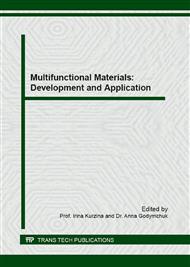[1]
Kulinets, Biomaterials and their application in medicine, in: S. Amato, B. Ezzell (Eds. ), Regulatory Affairs for Biomaterials and Medical Devices, Woodhead Publ., 2015, pp.1-10.
DOI: 10.1533/9780857099204.1
Google Scholar
[2]
P. Bartolo, J. -P. Kruth, J. Silva, G. Levy, A. Malshe, K. Rajurkar, M. Mitsuishu, J. Ciurana, M. Leu, Biomedical production of implants by additive electro-chemical and physical processes, CIRP Annals – Manuf. Technol. 61 (2012) 635-655.
DOI: 10.1016/j.cirp.2012.05.005
Google Scholar
[3]
P. Chandra, J. J. Yoo, S.J. Lee, Biomaterials in Regenerative Medicine: Challenges in Technology Transfer from Science to Process Development, in: A. Atala, J. Allikson (Eds. ), Translation Regenerative Medicine, Academic Press, 2015, pp.151-167.
DOI: 10.1016/b978-0-12-410396-2.00013-x
Google Scholar
[4]
T.T. Dang, M. Nikkhah, A. Memic, A. Khademhosseini, Polymeric Biomaterials for ImPLAanable Prostheses, Challenges in Technology Transfer from Science to Process Development, in: A. Atala, J. Allikson (Eds. ), Translation Regenerative Medicine, Academic Press, 2015, pp.309-331.
DOI: 10.1016/b978-0-12-396983-5.00020-x
Google Scholar
[5]
J. Goswami, Processing and characterization of poly(lactic acid) based bioactive composites for biomedical scaffold application, eXPRESS Polym. Lett. 7 (2013) 767-777.
DOI: 10.3144/expresspolymlett.2013.74
Google Scholar
[6]
B. Ben-Nissan, Advances in Calcium Phosphate Biomaterials, Spinger, (2014).
Google Scholar
[7]
Y. Cui, Y. Liu, Y. Cuietal, The nanocomposite scaffold of poly(lactide-co-glicolide) and hydroxyapatite surface-grafted with L-lactic acid oligomer for bone repair, ActaBiomaterialia 5 (2009) 2680-2692.
DOI: 10.1016/j.actbio.2009.03.024
Google Scholar
[8]
A. Popova, J. Kzhyshkowska, D. Nurgazieva, S. Goerdt, A. Gratchev, Pro- and anti-inflammatory control of M-CSF-mediated macrophage differentiation, Immunobiology 216 (2011) 164-172.
DOI: 10.1016/j.imbio.2010.06.003
Google Scholar
[9]
J. Kzhyshkowska, C. Neyen, S. Gordon, Role of macrophage scavenger receptors in atherosclerosis, Immunobiology, 217 (2012) 492-502.
DOI: 10.1016/j.imbio.2012.02.015
Google Scholar
[10]
U. Dapunt, S. Maurer, T. Giese, M.M. Gaida, G.M. Hänsch, The macrophage inflammatory proteins MIP1a (CCL3) and MIP2a (CXCL2) in implant-associated osteomyelitis: linking inflammation to bone degradation, Mediators Inflamm., 2014 (2014) 728619.
DOI: 10.1155/2014/728619
Google Scholar
[11]
T. Kokubo, Bioactive glass ceramics: properties and applications, Biomaterials 12 (1991) 155-163.
DOI: 10.1016/0142-9612(91)90194-f
Google Scholar
[12]
L. A. Rasskazova, N. M. Korotchenko, G. M. Zeer, Microwave synthesis of hydroxyapatite and physicochemical study of its properties, Russ. J. Appl. Chem. 86 (2013) 691-695.
DOI: 10.1134/s1070427213050145
Google Scholar
[13]
L.A. Rasskazova, D.N. Lytkina, Y.G. Shapovalova, V.V. Botvin, M.A. Pozdnyakov, I.V. Zhuk, A.G. Filimoshkin, N.M. Korotchenko, V.V. Kozik, Bioactivity and Physico-Chemical Properties of Composites on Basis of Hydroxyapatite with Lactic and Glycolic Acids Oligomers, Adv. Mat. Res. 1085 (2015).
DOI: 10.4028/www.scientific.net/amr.1085.394
Google Scholar
[14]
A. Gratchev, J. Kzhyshkowska, K. Kothe, I. Muller-Molinet,S. Kannookadan, J. Utikal, S. Goerdt, M1 and M2 can be re-polarized by Th2 or Th1 cytokines, respectively, and respond to exogenous danger signals, Immunobiol. 211 (2006) 473-486.
DOI: 10.1016/j.imbio.2006.05.017
Google Scholar


